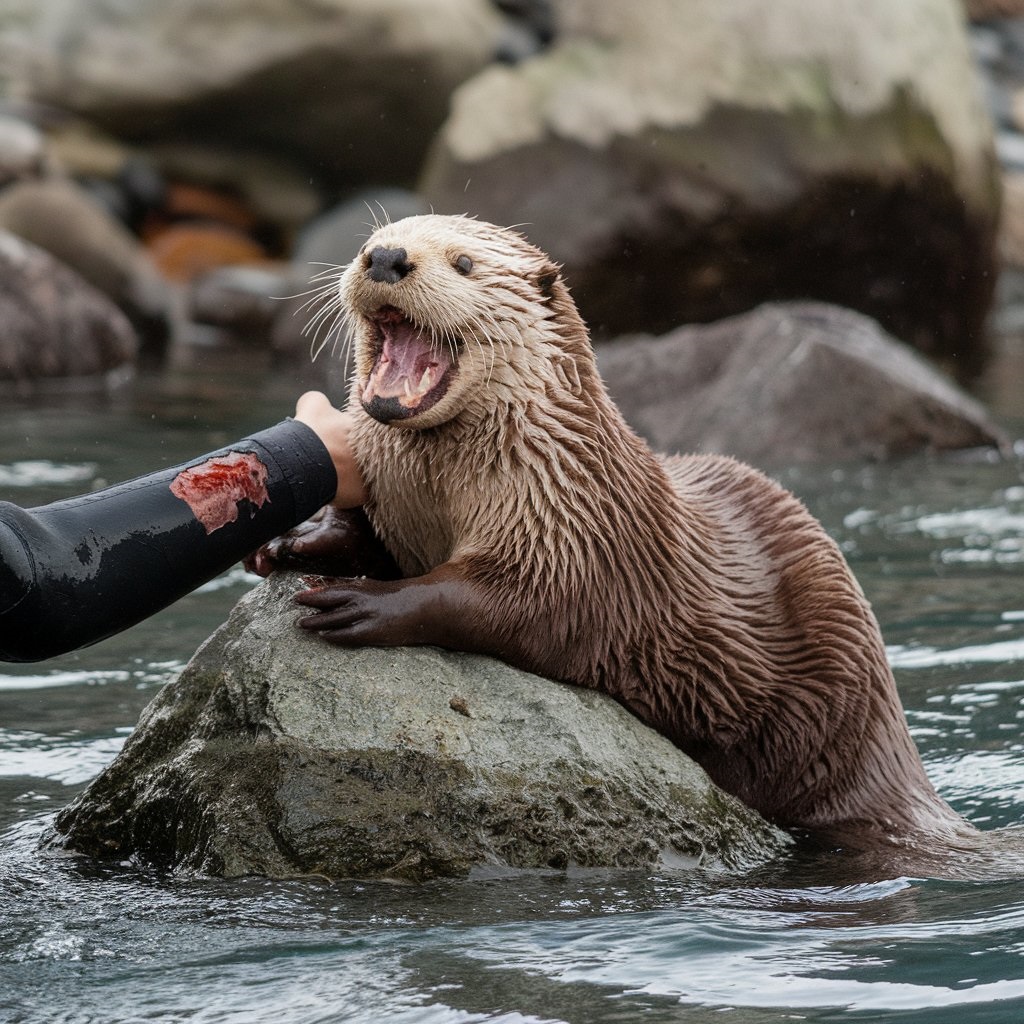Otters are often associated with their playful antics and adorable appearances. You’ve likely seen them holding hands while floating in the water or cracking open shellfish with stones. But as charming as they may seem, otters aren’t always the harmless creatures we imagine. Beneath their cuddly exterior lies a territorial and protective nature that can sometimes lead to aggressive behavior—especially toward humans.So, do otters attack humans?
While attacks are rare, they can happen under specific circumstances, and the consequences can range from minor injuries to severe infections. This article dives deep into the dark side of otters, exploring their habitats, behavior, reasons for aggression, and how to avoid risky encounters.
Here’s a comprehensive table summarizing the key facts and figures from the article:
| Category | Fact/Figure |
|---|---|
| Number of Otter Species | 13 globally |
| Common Otter Species | North American River Otter, Sea Otter, Eurasian Otter |
| Otter Habitat | Rivers, lakes, wetlands, coastal areas, marine environments |
| Size of Otters | North American River Otter: 2.5–4 feet, up to 30 pounds; Sea Otter: 4–5 feet, up to 90 pounds; Eurasian Otter: 2–3 feet, up to 26 pounds |
| Primary Diet | Fish, crustaceans, mollusks, small aquatic animals |
| Frequency of Otter Attacks | 39 documented cases worldwide (1875–2013), per CDC |
| Causes of Otter Aggression | Territorial defense, protection of offspring, provocation, environmental stress |
| Warning Signs of Aggression | Hissing, growling, baring teeth, charging |
| Potential Injuries | Puncture wounds, lacerations, drowning attempts |
| Health Risks | Infections from Pasteurella multocida, potential rabies |
| Infection Symptoms | Redness, swelling, fever, severe pain |
| Preventive Measures | Stay 50 feet away from otters, avoid dens, do not feed otters, supervise pets |
| Medical Treatment | Wound cleaning, antibiotics, rabies vaccination (if necessary) |
| Conservation Needs | Preserving wetlands and rivers, reducing pollution, educating communities |
| Interesting Fact | Sea otters use tools like rocks to crack open shellfish |
| Largest Otter | Giant River Otter: Up to 6 feet long, 70 pounds |
| Smallest Otter | Asian Small-Clawed Otter: 2 feet long, around 11 pounds |
What Are Otters?
Otters are fascinating creatures belonging to the Mustelidae family, which includes relatives like weasels, badgers, and ferrets. There are 13 species of otters worldwide, and each has unique traits that make them well-suited to their environment.

Physical Description
Otters are built for life in and around water. Their streamlined bodies and webbed feet allow them to swim efficiently, while their dense, waterproof fur helps them stay warm in cold aquatic environments. Their fur is so effective at insulation that sea otters can survive in icy waters without needing a layer of blubber like seals or whales.
Here’s a quick comparison of common otter species:
| Species | Size | Habitat | Key Features |
|---|---|---|---|
| North American River Otter | 2.5–4 feet long, up to 30 pounds | Rivers, lakes, and wetlands | Sleek body, playful behavior, freshwater-only |
| Sea Otter | 4–5 feet long, up to 90 pounds | Coastal waters | Marine-only, uses tools like rocks |
| Eurasian Otter | 2–3 feet long, up to 26 pounds | Rivers and coastal areas | Solitary, wide distribution in Europe & Asia |
Habitat and Distribution
Otters inhabit a wide range of environments, from freshwater habitats like rivers, lakes, and wetlands to marine environments along coastlines. They are found on every continent except Antarctica and Australia.
While they typically avoid humans, increasing urbanization and habitat destruction have brought otters closer to human settlements, especially in regions where rivers and wetlands intersect with developed areas.
Behavior and Diet
Otters are known for their playful nature, often seen sliding on riverbanks or playing with each other in water. But behind their carefree image lies a territorial streak, especially when protecting their dens or offspring.
Their diet is primarily carnivorous, focusing on:
- Fish, which forms the bulk of their meals.
- Crustaceans like crabs and lobsters.
- Mollusks such as clams and mussels.
- Small aquatic animals, including frogs and even small birds.
This reliance on aquatic food makes otters excellent hunters, but it also means they’ll fiercely defend their feeding grounds if threatened.
Do Otters Attack Humans?
Frequency of Otter Attacks
The question “Do otters attack humans?” can be answered with a cautious “yes.” While attacks are uncommon, they are not unheard of. According to a CDC study, there were 39 documented cases of otter attacks between 1875 and 2013. Of these, 24 involved North American river otters, and 15 involved sea otters.
Many of these incidents occurred when humans unintentionally encroached on otter habitats. However, not all attacks are defensive—some result from the otters’ natural curiosity, especially if they feel cornered or provoked.
Reasons for Otter Aggression
Otters are not naturally aggressive, but certain circumstances can trigger an attack:
- Territorial Defense
Otters are highly territorial, especially when defending their dens, known as holts. If they perceive a human as a threat to their space, they may attack. - Protection of Offspring
Mother otters are particularly defensive when their pups are nearby. Any approach, even unintentional, can result in aggressive behavior. - Perceived Threats
Otters interpret actions like swimming near their territory, fishing, or even walking along riverbanks as a potential threat. - Environmental Stress
Habitat destruction, pollution, and food scarcity can make otters more irritable and prone to attacking humans.
Patterns of Aggression
Otters often give warning signs before becoming aggressive. These include:
- Hissing or growling.
- Raising their tails or standing on hind legs.
- Charging toward the perceived threat.
Ignoring these signs can lead to physical attacks, which may escalate if the otter feels cornered.

Are Otter Attacks Dangerous?
Severity of Injuries
Otters might look small, but their sharp teeth and powerful jaws can inflict serious damage. Injuries from otter attacks often include:
- Deep puncture wounds and lacerations.
- Severe scratches caused by their claws.
- In rare cases, otters have attempted to drown their victims by dragging them underwater.
One notable incident occurred in Alaska, where a group of otters attacked a child, leaving them with multiple wounds requiring medical attention.
Health Risks from Otter Bites
The dangers of otter attacks extend beyond physical injuries. Bacteria present in their mouths and claws can cause severe infections, including:
- Pasteurella multocida: A common bacterium found in animal bites that can lead to swelling, fever, and, in severe cases, hospitalization.
- Rabies: Although rare in otters, rabies is a possibility if the animal is infected.
Symptoms of Infection:
- Redness and swelling around the wound.
- Fever, chills, and fatigue.
- Pus or discharge from the bite area.
Immediate medical attention is essential to prevent complications, especially for bites that occur near joints or deep tissue.
How to Avoid Otter Attacks
Respecting Otter Habitats
The easiest way to prevent otter attacks is to respect their space. Here’s how:
- Avoid approaching areas where otters are known to live, such as rivers, lakes, and coastal wetlands.
- Never attempt to feed otters, as this encourages them to lose their natural fear of humans.
- Keep a safe distance, ideally at least 50 feet, when observing otters in the wild.
Best Practices for Coexistence
If you find yourself in an area with otters, follow these precautions:
- Stay calm: Sudden movements can alarm otters and provoke a defensive reaction.
- Keep pets away: Dogs, in particular, can provoke otters, leading to aggressive encounters.
- Observe from afar: Use binoculars for wildlife watching rather than getting too close.
What to Do if You Encounter an Aggressive Otter
If you encounter an otter showing signs of aggression:
- Back away slowly without turning your back on the animal.
- Make loud noises, such as clapping or shouting, to scare it away.
- If attacked, protect your face and neck and try to escape the water if applicable.
- Seek immediate medical attention after an attack to address any injuries or potential infections.

Preventive Measures and Public Awareness
Wildlife Safety Education
Raising awareness about wildlife interactions is crucial, especially for communities living near otter habitats. Educational efforts can include:
- Workshops on recognizing aggression indicators in otters.
- Training children to avoid playing near otter dens or feeding them.
Conservation Efforts
Efforts to conserve otter habitats benefit both otters and humans. By preserving their natural environments, we reduce stress-related aggression. Conservation strategies include:
- Protecting wetlands and coastal ecosystems.
- Limiting pollution in freshwater and marine habitats.

FAQs
1. Are otters aggressive with humans?
Otters are usually shy around humans but can occasionally show aggression, especially if they feel threatened or become habituated to people.
2. Has anyone been attacked by an otter?
Although rare, there have been documented cases of otter attacks on humans, often due to territorial behavior or provocation.
3. How rare is an otter attack?
Otter attacks are uncommon, with only a few dozen cases reported over the past century, highlighting their general preference for avoiding humans.
4. What is the biggest threat to otters?
Oil spills pose the greatest risk to sea otters, potentially devastating populations due to their small numbers and limited habitats.
5. Is an otter a good pet?
Otters are unsuitable as pets since they are highly social, active animals that can become destructive and stressed in captivity.
6. What should you do if an otter bites you?
Seek immediate medical attention for otter bites, as they may transmit diseases like rabies and other infections.
7. Are sea otters friendly?
Sea otters are wild animals with unpredictable behavior; while some may seem friendly, others can act aggressively toward humans.
8. How strong is an otter’s bite?
Otters have a powerful bite, estimated at 615 pounds per square inch, making it significantly stronger than the average human bite.
9. What is the rarest otter species?
The hairy-nosed otter, native to Southeast Asia, is the rarest otter in the world and faces threats from habitat loss and poaching.
10. Do otters have pockets?
Sea otters have loose skin under their forearms, creating natural “pockets” to store food and tools like rocks for cracking shells.
Final Verdict: The Dark Side of Otters
Otters are undoubtedly among nature’s most fascinating animals. While their playful demeanor and charming antics make them popular, their territorial instincts and protective behavior remind us to respect them as wild creatures.
Key Takeaways:
- Do otters attack humans? Yes, but attacks are rare and typically occur when humans encroach on their space.
- Otter bites can lead to serious injuries and infections, including Pasteurella multocida and, in rare cases, rabies.
- The best way to avoid otter aggression is to respect their habitats and keep a safe distance.
By staying informed and exercising caution, we can coexist peacefully with these remarkable animals while appreciating them from a safe distance. Let the dark side of otters serve as a reminder of the importance of respecting wildlife.
Read more knowledgeable blogs on Flowy Magazine

James Clair is a passionate writer and researcher with a deep fascination for animal behavior and its intricate connection to human life. With a background in [relevant field of study, e.g., zoology, psychology, ethology], James has spent years studying the natural world, focusing on how animals’ actions and instincts impact human emotions, behavior, and society.
His expertise in [specific topics or regions of focus, e.g., canine psychology, animal communication, wildlife conservation] has led to numerous published works and collaborations with renowned researchers and institutions. Through his work at Flawy Magazine, James aims to bridge the gap between scientific research and public understanding, offering insightful, accessible articles that explore the complex relationship between humans and animals.
When he’s not writing, James enjoys [personal hobbies or interests, e.g., hiking in nature, volunteering at animal shelters, photography] and is an advocate for [cause or charity related to animals or conservation]. His mission is to inspire readers to see animals not just as companions or creatures of the wild, but as beings whose behavior holds valuable lessons for us all.









